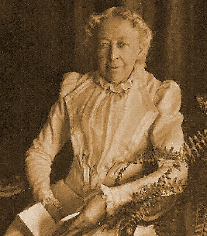 Picture source: Thayer Library, Keene (NH)
Picture source: Thayer Library, Keene (NH)
Julia B. Thayer donated the fountain to the town in 1900. She was born in Winchester, New Hampshire, daughter of David Ball (1801-1864) of Warwick (Massachusetts) and Fanny Capron (1806-1863). She was a music teacher in Ashuelot and Winchester (New Hampshire). In 1873 she married Edward Carrington Thayer (1828-1898) and moved to Keene, New Hampshire. She was active and well known in her community as a suffragist, civic leader, and philanthropist. Mrs. Thayer and her husband donated to many causes including hospitals, libraries (including the Thayer Library in Keene), churches, and the public drinking fountain in Warwick.
Image: Warwick (MA) Historical Society
Captain David Ball was born in Warwick, Massachusetts. He was the son of David Ball (1780-1865) of Warwick, Massachusetts, and Elizabeth Rice (1786-1874). He enlisted in the Vermont 16th Regiment, and saw battle during the Civil War on the fields of Gettysburg (1863). He returned to Warwick and became one of the town's most revered veterans. Charles Morse, in his book 'Warwick Massachusetts, a biography of a town' (1963) wrote how Captain Ball was often the marshall in the annual Memorial Day Parade. For years at the exercises in the cemetery the firing squad has stood near his grave to fire their 'Salute to the Dead'.- Charles Morse, 1963.
Image: Blackstone Valley Historical Society
Henry F. Jenks was also familiarly known as Captain H. F. Jenks. He is descended in the seventh generation from Joseph Jenckes, Jr. who was the first settler to Pawtucket, Rhode Island. He is sixth generation descended from Governor Joseph Jenks. His father was William T. Jenks (1795), and his mother Patience Hall from Hardwick, Massachusetts. He received a mechanical education and became an inventor who worked in several different foundries. He was employed at Hope Iron Works in Providence (Rhode Island). He later was employed at William T. Nicholson (founder of Nicholson File Co), until 1866. He spent some time in the army and was also a member of the Pawtucket Light Guard, becoming Major and then Lieutenant-colonel. Messrs. Jenks & Co. was started in 1865. He opened his own foundry 'The Jenks Iron Foundry' where he started manufacturing fountains in 1871.
Picture source: Blackstone Valley Historical Society (BVHS) Archives
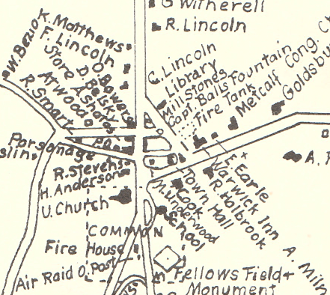
There has been uncertainty about if the name of the fountain is indeed Captain Ball's Fountain. No one really recognizes the fountain with that name. Typically it is known as the town fountain, or something similar.
According to the map created in 1963 by historian and former town resident Charles Morse, the fountain was once known as 'Captain Ball's Fountain'. Although most now know it as the town fountain, it is important to record its original title, assuming Charles Morse was correct. If the fountain was indeed named after Captain David Ball, it is perhaps in honor of a highly esteemed veteran of the Civil War.
Image: Charles Morse, Warwick, Massachusetts: Biography of a Town (Dresser, Chapman & Grimes, 1963).
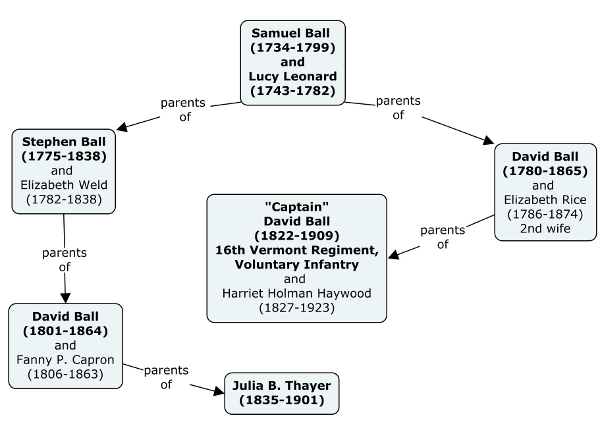
Another confusing part to the story of the fountain is which David Ball? There was more than one! In Charles Morse's Book (p.175) he says Julia is the daughter of Captain David Ball. This cannot be the same Captain David Ball on his black horse and Marshal of the Parade in 1881, described by Morse (p.170), as Julia's father died in 1864.
No mention is made in the newspaper clip of why the fountain was being donated or in whose honor. Perhaps the town later decided to dedicate the fountain to the highly revered Warwick veteran of the civil war and the famous battles on the fields of Gettysburg? Perhaps we will never know? If you have any ideas, comments, or find the real answer you can contact me here.
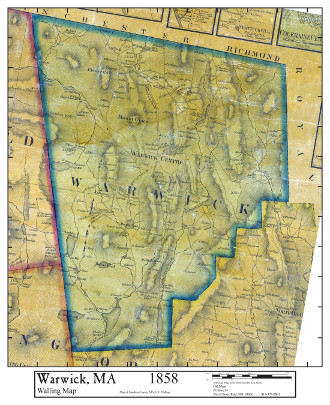
It is worth considering the potential uses of the fountain, and what a great gift it was to the town. There are some very interesting histories regarding fountains at that time such as the temperance movement and the humanitarian groups. Meanwhile the potential for bickering households having to share water, freezing pipes in the winter, dried up wells in the summer. There is much which could be researched and written about.
The Walling Map of 1858 shows the dwellings of two D. Balls living in the northern section of town. This is close to the water trough mentioned by Morse (p. 175), supposedly given to the town by Captain David Ball. This would have been a welcome water source for those living downhill from the center of town. The steep climb up through the gully would potentially have been quite difficult at times depending on the season.
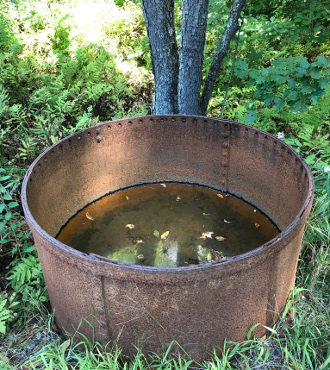
The fountain continues to provide a fresh source of drinking water. Power outages brings householders with their gallon plastic jugs, sometimes having to wait patiently in line. During dry spells in summer the fountain provides relief; even hoses have been known to be used to siphon off some water! Cyclists and hikers are often seen filling up their water bottles.
There are no doubt a lot more stories to be told. It would be particularly interesting to discover more about how the fountain is maintained. This may in part help document something which is intangible yet part of our cultural heritage. That is the way in which such a structure at that time was created, the mechanisms used, the processes, the way in which things were made in times gone by which may be very different to present manufacturing. Currently the cavity of a septic tank provides greater access to the plumbing. This was installed in 1979. Henry F, Jenks, the inventor of the fountain, created a system which cleverly prevented it from freezing. The patent illustration and some descriptions provide a little insight into how this fountain works, however there is no doubt more to research.
The sources page provides the sources of information used throughout this website. If you would like to provide more insight, stories, any useful pieces of information, you can contact me here.
Morse, Charles A., (1963). Warwick, Massachusetts: Biography of a town. Cambridge, Massachusetts: Dresser, Chapman & Grimes. https://archive.org/details/warwickmassachus00mors
The New England Ball Project: From the immigrants to the present. https://www.newenglandballproject.com/index.htm
You can find more research resources on the Sources Page